Effect of Interfacial Structure on Mechanical Properties of Graphene Reinforced Al2O3–WC Matrix Ceramic Composite
Abstract
:1. Introduction
2. Experimental Procedure
2.1. Preparation of Composite Powders
2.2. Two-Step Hot Pressing Sintering
2.3. Characterization
3. Results and Discussion
3.1. Microstructures
3.2. Mechanical Properties
3.3. Strengthening and Toughening Mechanisms
4. Conclusions
Author Contributions
Funding
Acknowledgments
Conflicts of Interest
References
- Lee, C.; Wei, X.; Kysar, J.W.; Hone, J. Measurement of the elastic properties and intrinsic strength of monolayer graphene. Science 2008, 321, 385–388. [Google Scholar] [CrossRef] [PubMed]
- Hou, Z.-L.; Song, W.-L.; Wang, P.; Meziani, M.J.; Kong, C.Y.; Anderson, A.; Maimaiti, H.; LeCroy, G.E.; Qian, H.; Sun, Y.-P. Flexible Graphene–Graphene Composites of Superior Thermal and Electrical Transport Properties. ACS Appl. Mater. Interfaces 2014, 6, 15026–15032. [Google Scholar] [CrossRef]
- Grigoriev, S.; Peretyagin, P.; Smirnov, A.; Solís, W.; Díaz, L.; Fernández, A.; Torrecillas, R. Effect of graphene addition on the mechanical and electrical properties of Al2O3-SiCw ceramics. J. Eur. Ceram. Soc. 2017, 37, 2473–2479. [Google Scholar] [CrossRef]
- Cheng, Y.; Zhang, Y.; Wan, T.; Yin, Z.; Wang, J. Mechanical properties and toughening mechanisms of graphene platelets reinforced Al2O3/TiC composite ceramic tool materials by microwave sintering. Mater. Sci. Eng. A 2017, 680, 190–196. [Google Scholar] [CrossRef]
- Wang, X.; Zhao, J.; Cui, E.; Song, S.; Liu, H.; Song, W. Microstructure, mechanical properties and toughening mechanisms of graphene re-inforced Al2O3-WC-TiC composite ceramic tool material. Ceram. Int. 2019, 45, 10321–10329. [Google Scholar] [CrossRef]
- Chu, K.; Wang, F.; Li, Y.-B.; Wang, X.-H.; Huang, D.-J.; Geng, Z.-R. Interface and mechanical/thermal properties of graphene/copper composite with Mo2C nanoparticles grown on graphene. Compos. Part A Appl. Sci. Manuf. 2018, 109, 267–279. [Google Scholar] [CrossRef]
- Ju, B.; Yang, W.; Shao, P.; Hussain, M.; Zhang, Q.; Xiu, Z.; Hou, X.; Qiao, J.; Wu, G. Effect of interfacial microstructure on the mechanical properties of GNPs/Al composites. Carbon 2020, 162, 346–355. [Google Scholar] [CrossRef]
- Mu, X.N.; Cai, H.N.; Zhang, H.M.; Fan, Q.B.; Zhang, Z.H.; Wu, Y.; Ge, Y.X.; Wang, D.D. Interface evolution and superior tensile properties of multi-layer graphene rein-forced pure Ti matrix composite. Mater. Des. 2018, 140, 431–441. [Google Scholar] [CrossRef]
- Bódis, E.; Cora, I.; Németh, P.; Tapasztó, O.; Mohai, M.; Tóth, S.; Károly, Z.; Szépvölgyi, J. Toughening of silicon nitride ceramics by addition of multilayer graphene. Ceram. Int. 2019, 45, 4810–4816. [Google Scholar] [CrossRef]
- Cheng, Y.; Lyu, Y.; Han, W.; Hu, P.; Zhou, S.; Zhang, X. Multiscale toughening of ZrB2-SiC-Graphene@ZrB2-SiC dual composite ceramics. J. Am. Ceram. Soc. 2019, 102, 2041–2052. [Google Scholar] [CrossRef]
- Sigh, L.S. Microcrack toughening in brittle materials containing weak and strong interfaces. Acta Mater. 1996, 44, 3599–3609. [Google Scholar]
- Liu, X.; Wang, F.; Wu, H.; Wang, W. Strengthening metal nanolaminates under shock compression through dual effect of strong and weak graphene interface. Appl. Phys. Lett. 2014, 104, 231901. [Google Scholar] [CrossRef]
- Sun, J.; Zhao, J.; Huang, Z.; Yan, K.; Chen, F.; Jian, Y.; Yang, H.; Li, B. Preparation and properties of multilayer graphene reinforced binderless TiC nano-composite cemented carbide through two-step sintering. Mater. Des. 2020, 188, 108495. [Google Scholar] [CrossRef]
- Zhang, X.; Shi, C.; Liu, E.; Zhao, N.; He, C. Effect of interface structure on the mechanical properties of graphene nanosheets rein-forced copper matrix composites. ACS Appl. Mater. Interfaces 2018, 10, 37586–37601. [Google Scholar] [CrossRef] [PubMed]
- Goyenola, C.; Stafström, S.; Hultman, L.; Gueorguiev, A.G. Structural patterns arising during synthetic growth of fullerene-like sul-focarbide. J. Phys. Chem. C 2012, 116, 21124–21131. [Google Scholar] [CrossRef]
- Lee, Y.-I.; Kim, Y.-W.; Mitomo, M.; Kim, D.-Y. Fabrication of Dense Nanostructured Silicon Carbide Ceramics through Two-Step Sintering. J. Am. Ceram. Soc. 2003, 86, 1803–1805. [Google Scholar] [CrossRef]
- Bodišová, K.; Galusek, D.; Švančárek, P.; Pouchlý, V.; Maca, K. Grain growth suppression in alumina via doping and two-step sintering. Ceram. Int. 2015, 41, 11975–11983. [Google Scholar] [CrossRef]
- Hong, D.; Yin, Z.; Yan, S.; Xu, W. Fine grained Al2O3/SiC composite ceramic tool material prepared by two-step microwave sintering. Ceram. Int. 2019, 45, 11826–11832. [Google Scholar] [CrossRef]
- Lin, F.J.; de Jonghe, L.C.; Rahaman, M.N. Microstructure refinement of sintered alumina by a two-step sintering technique. J. Am. Ceram. Soc. 1997, 80, 2269–2277. [Google Scholar] [CrossRef]
- Wang, X.; Zhao, J.; Cui, E.; Liu, H.; Dong, Y.; Sun, Z. Effects of sintering parameters on microstructure, graphene structure stability and mechanical properties of graphene reinforced Al2O3-based composite ceramic tool material. Ceram. Int. 2019, 45, 23384–23392. [Google Scholar] [CrossRef]
- Anstis, G.R.; Chantikul, P.; Lawn, B.R.; Marshall, D.B. A critical evaluation of indentation techniques for measuring fracture toughness: Ⅰ, direct crack measurements. J. Am. Ceram. Soc. 1981, 64, 533–538. [Google Scholar] [CrossRef]
- Li, M.; Zhang, Z.; Gao, H.; Wang, Y.; Liang, J.; Shu, D.; Wang, J.; Sun, B. Formation of multilayer interfaces and the load transfer in graphene nanoplatelets rein-forced Al matrix composites. Mater. Charact. 2020, 159, 110018. [Google Scholar] [CrossRef]
- Liu, J.; Guo, H.; Su, Y.; Wang, L.; Wei, L.; Yang, G.; Yang, Y.; Jiang, K. Spark plasma sintering of graphene platelet reinforced zirconia composites with improved mechanical performance. Mater. Sci. Eng. A 2017, 688, 70–75. [Google Scholar] [CrossRef]
- Wu, W.; Gui, J.; Sai, W.; Xie, Z. The reinforcing effect of graphene nano-platelets on the cryogenic mechanical properties of GNPs/Al2O3 composites. J. Alloys Compd. 2017, 691, 778–785. [Google Scholar] [CrossRef]
- Nieto, A.; Lahiri, D.; Agarwal, A. Graphene nanoplatelets reinforced tantalum carbide consolidated by spark plasma sin-tering. Mater. Sci. Eng. A 2013, 582, 338–346. [Google Scholar] [CrossRef] [Green Version]
- Wang, X.; Zhao, J.; Cui, E.; Sun, Z.; Yu, H. Grain growth kinetics and grain refinement mechanism in Al2O3/WC/TiC/graphene ceramic composite. J. Eur. Ceram. Soc. 2021, 41, 1391–1398. [Google Scholar] [CrossRef]
- Ma, Y.-H.; Ouyang, J.-H.; Wang, Z.-G.; Henniche, A.; Wang, Y.-H.; Wang, Y.-J.; Liu, Z.-G. Insights into intragranular precipitation and strengthening effect in Al2O3/SmAlO3 ceramic with eutectic composition. Mater. Sci. Eng. A 2019, 754, 382–389. [Google Scholar] [CrossRef]
- Xiao, P.; Gao, Y.; Xu, F.; Yang, S.; Li, B.; Li, Y.; Huang, Z.; Zheng, Q. An investigation on grain refinement mechanism of TiB2 particulate reinforced AZ91 composites and its effect on mechanical properties. J. Alloys Compd. 2019, 780, 237–244. [Google Scholar] [CrossRef]
- Xu, C.; Sun, D. Formation of intragranular nano-structures in micro-sized ceramic composite materials. Mater. Sci. Eng. A 2008, 491, 338–342. [Google Scholar] [CrossRef]
- Liu, Y.; Jiang, X.; Shi, J.; Luo, Y.; Tang, Y.; Wu, Q.; Luo, Z. Research on the interface properties and strengthening–toughening mechanism of nanocarbon-toughened ceramic matrix composites. Nanotechnol. Rev. 2020, 9, 190–208. [Google Scholar] [CrossRef] [Green Version]
- Ahmad, I.; Unwin, M.; Cao, H.; Chen, H.; Zhao, H.; Kennedy, A.; Zhu, Y.Q. Multi-walled carbon nanotubes reinforced Al2O3 nanocomposites: Mechanical properties and interfacial investigations. Compos. Sci. Technol. 2010, 70, 1199–1206. [Google Scholar] [CrossRef]
- Wang, X.; Zhao, J.; Cui, E.; Sun, Z.; Yu, H. Nano/microstructures and mechanical properties of Al2O3-WC-TiC ceramic composites incorporating graphene with different sizes. Mater. Sci. Eng. A 2021, 812, 141132. [Google Scholar] [CrossRef]
- Zeng, X.; Xiao, X.; Zhang, W.; Wan, C.; Wang, H. Interfacial charge transfer and mechanisms of enhanced photocatalysis of an anatase TiO2(0 0 1)-MoS2-graphene nanocomposite: A first-principles investigation. Comput. Mater. Sci. 2017, 126, 43–51. [Google Scholar] [CrossRef]
- Chu, K.; Wang, F.; Li, Y.-B.; Wang, X.-H.; Huang, D.-J.; Zhang, H. Interface structure and strengthening behavior of graphene/CuCr composites. Carbon 2018, 133, 127–139. [Google Scholar] [CrossRef]
- Chang, C.; Li, X.; Xu, Z.; Gao, H. Lithiation-enhanced charge transfer and sliding strength at the silicon-graphene interface: A first-principles study. Acta Mech. Solida Sin. 2017, 30, 254–262. [Google Scholar] [CrossRef]
- Sun, S.; Zhang, X.; Wang, S. First-principles investigation on the bonding mechanism between graphyne and the (111) surface of Cu, Ag and Au. Mater. Res. Express 2020, 7, 065603. [Google Scholar] [CrossRef]
- Zhao, W.; Zhao, Z.; Bai, P.; Zhang, L.; Han, B.; Du, W. Zhao The Interfacial Characteristics of Graphene/Al4C3 in Graphene/AlSi10Mg Composites Prepared by Selective Laser Melting: First Principles and Experimental Results. Materials 2020, 13, 702. [Google Scholar] [CrossRef] [Green Version]
- Zhao, Z.; Zhao, W.; Bai, P.; Wu, L.; Huo, P. The interfacial structure of Al/Al4C3 in graphene/Al composites prepared by selective laser melting: First-principles and experimental. Mater. Lett. 2019, 255, 126559. [Google Scholar] [CrossRef]
- Porwal, H.; Tatarko, P.; Grasso, S.; Khaliq, J.; Dlouhý, I.; Reece, M.J. Graphene reinforced alumina nano-composites. Carbon 2013, 64, 359–369. [Google Scholar] [CrossRef]
- Chen, Y.-F.; Bi, J.-Q.; Yin, C.-L.; You, G.-L. Microstructure and fracture toughness of graphene nanosheets/alumina composites. Ceram. Int. 2014, 40, 13883–13889. [Google Scholar] [CrossRef]
- Duntu, S.H.; Tetteh, F.; Ahmad, I.; Islam, M.; Boakye-Yiadom, S. Characterization of the structure and properties of processed alumina-graphene and alumina-zirconia composites. Ceram. Int. 2021, 47, 367–380. [Google Scholar] [CrossRef]
- Zhou, W.; Fan, Y.; Feng, X.; Kikuchi, K.; Nomura, N.; Kawasaki, A. Creation of individual few-layer graphene incorporated in an aluminum matrix. Compos. Part A Appl. Sci. Manuf. 2018, 112, 168–177. [Google Scholar] [CrossRef]
- Liu, J.; Yan, H.; Jiang, K. Mechanical properties of graphene platelet-reinforced alumina ceramic composites. Ceram. Int. 2013, 39, 6215–6221. [Google Scholar] [CrossRef]
- Hrubovčáková, M.; Múdra, E.; Bureš, R.; Kovalčíková, A.; Sedlák, R.; Girman, V.; Hvizdoš, P. Microstructure, fracture behaviour and mechanical properties of conductive alumina based composites manufactured by SPS from graphenated Al2O3 powders. J. Eur. Ceram. Soc. 2020, 40, 4818–4824. [Google Scholar] [CrossRef]
- Li, Z.; Zhao, J.; Sun, J.; Gong, F.; Ni, X. Reinforcement of Al2O3/TiC ceramic tool material by multi-layer graphene. Ceram. Int. 2017, 43, 11421–11427. [Google Scholar] [CrossRef]
- Xu, Z.; Zhang, X.; Zhao, N.; He, C. Synergistic strengthening effect of in-situ synthesized WC1-x nanoparticles and graphene nanosheets in copper matrix composites. Compos. Part A Appl. Sci. Manuf. 2020, 133, 105891. [Google Scholar] [CrossRef]
- Feng, S.; Guo, Q.; Li, Z.; Fan, G.; Li, Z.; Xiong, D.B.; Su, Y.; Tan, Z.; Zhang, J.; Zhang, D. Strengthening and toughening mechanisms in graphene-Al nanolaminated composite micro-pillars. Acta Mater. 2017, 125, 98–108. [Google Scholar] [CrossRef]
- Sun, C.; Zhang, X.; Zhao, N.; He, C. Influence of spark plasma sintering temperature on the microstructure and strengthening mechanisms of discontinuous three-dimensional graphene-like network reinforced Cu matrix composites. Mater. Sci. Eng. A 2019, 756, 82–91. [Google Scholar] [CrossRef]
- Dong, L.; Lu, J.; Fu, Y.; Huo, W.; Liu, Y.; Li, D.; Zhang, Y. Carbonaceous nanomaterial reinforced Ti-6Al-4V matrix composites: Properties, interfacial structures and strengthening mechanisms. Carbon 2020, 164, 272–286. [Google Scholar] [CrossRef]
- Liu, Z.; Wang, L.; Zan, Y.; Wang, W.; Xiao, B.; Wang, D.; Wang, Q.; Ni, D.; Ma, Z. Enhancing strengthening efficiency of graphene nano-sheets in aluminum matrix composite by improving interface bonding. Compos. Part B Eng. 2020, 199, 108268. [Google Scholar] [CrossRef]
- Xiang, Y.; Wang, X.; Hu, X.; Meng, L.; Song, Z.; Li, X.; Sun, Z.; Zhang, Q.; Wu, K. Achieving ultra-high strengthening and toughening efficiency in carbon nanotubes/magnesium composites via constructing micro-nano layered structure. Compos. Part A 2019, 119, 225–234. [Google Scholar] [CrossRef]
- Li, S.; Luo, X.; Wei, C.; Gao, P.; Wang, P.; Zhou, L. Enhanced strength and toughness of silicon carbide ceramics by graphene platelet-derived laminated reinforcement. J. Alloys Compd. 2020, 834, 155252. [Google Scholar] [CrossRef]
- Sun, J.; Zhao, J. Multi-layer graphene reinforced nano-laminated WC-Co composites. Mater. Sci. Eng. A 2018, 723, 1–7. [Google Scholar] [CrossRef]
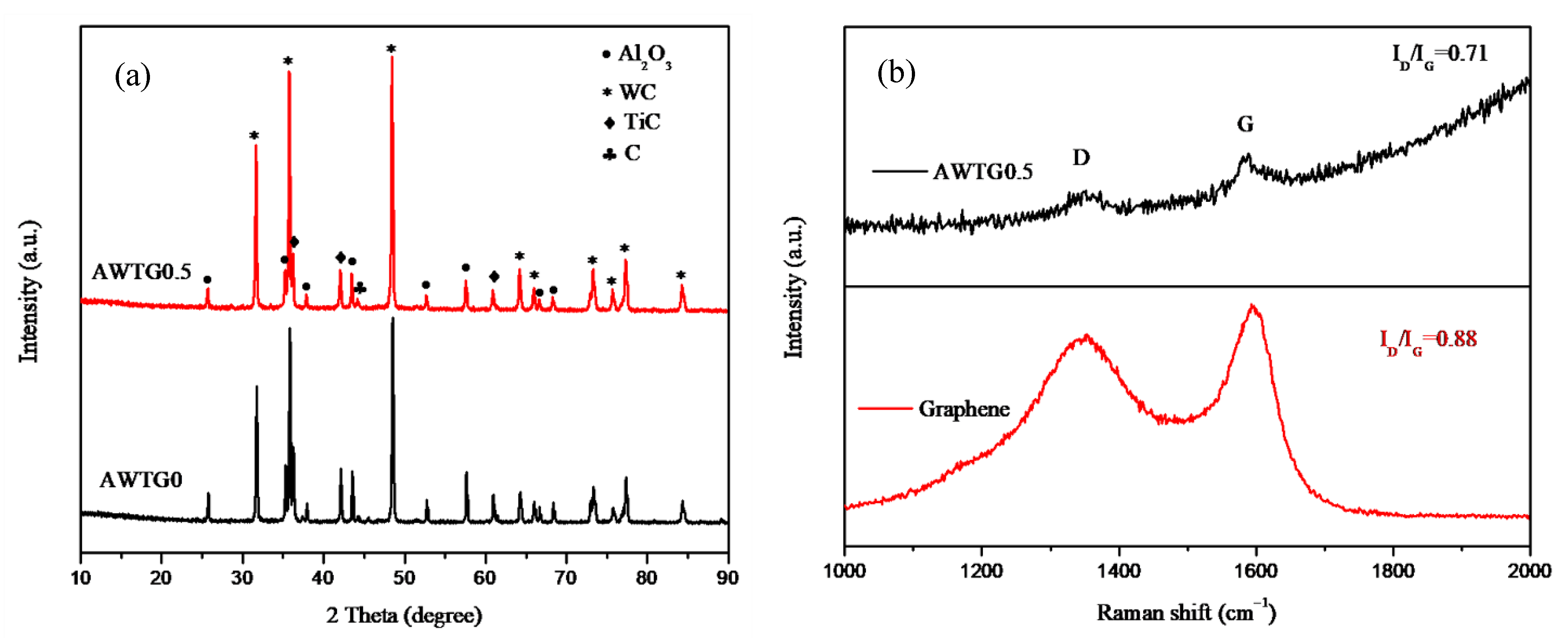
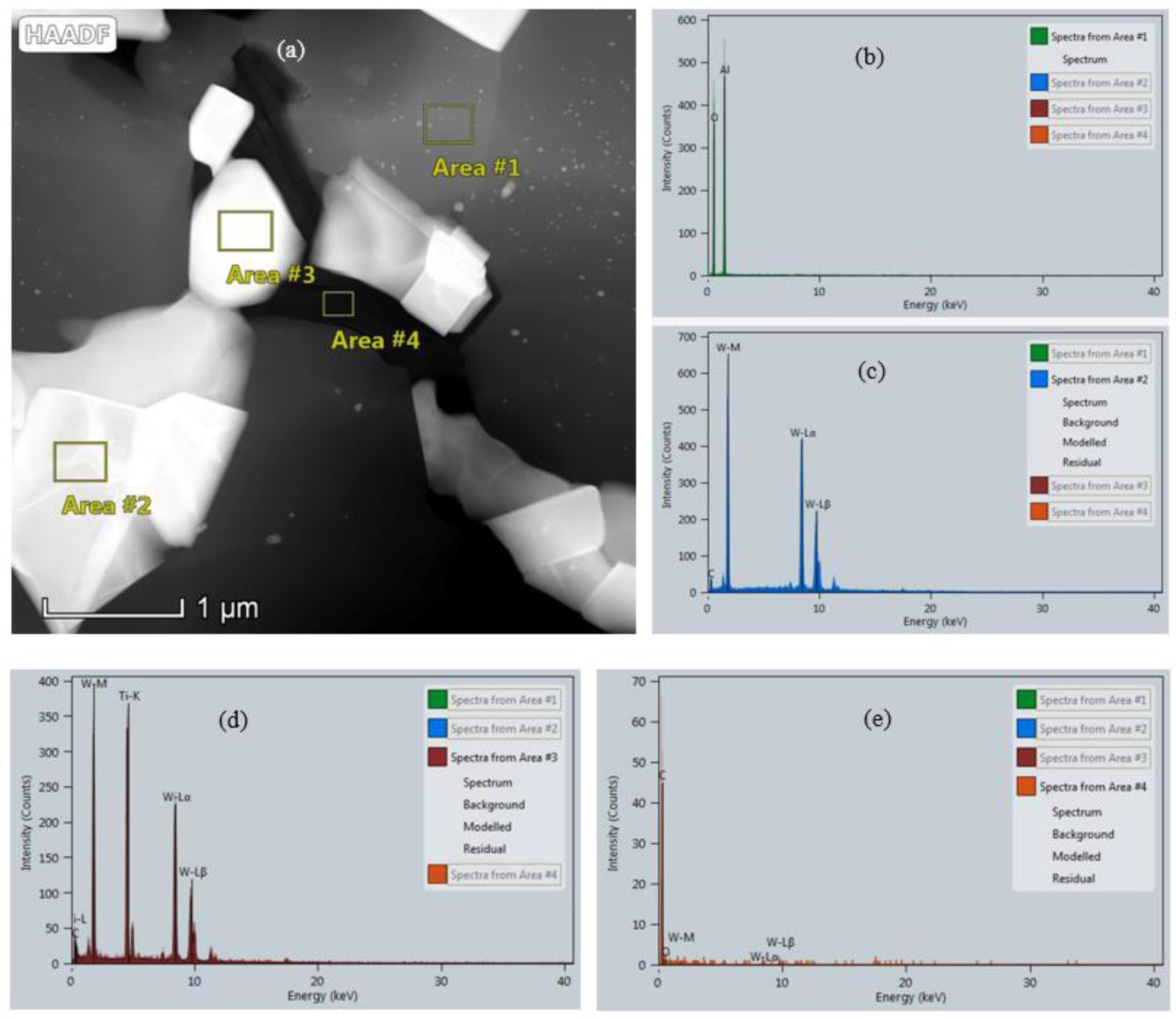


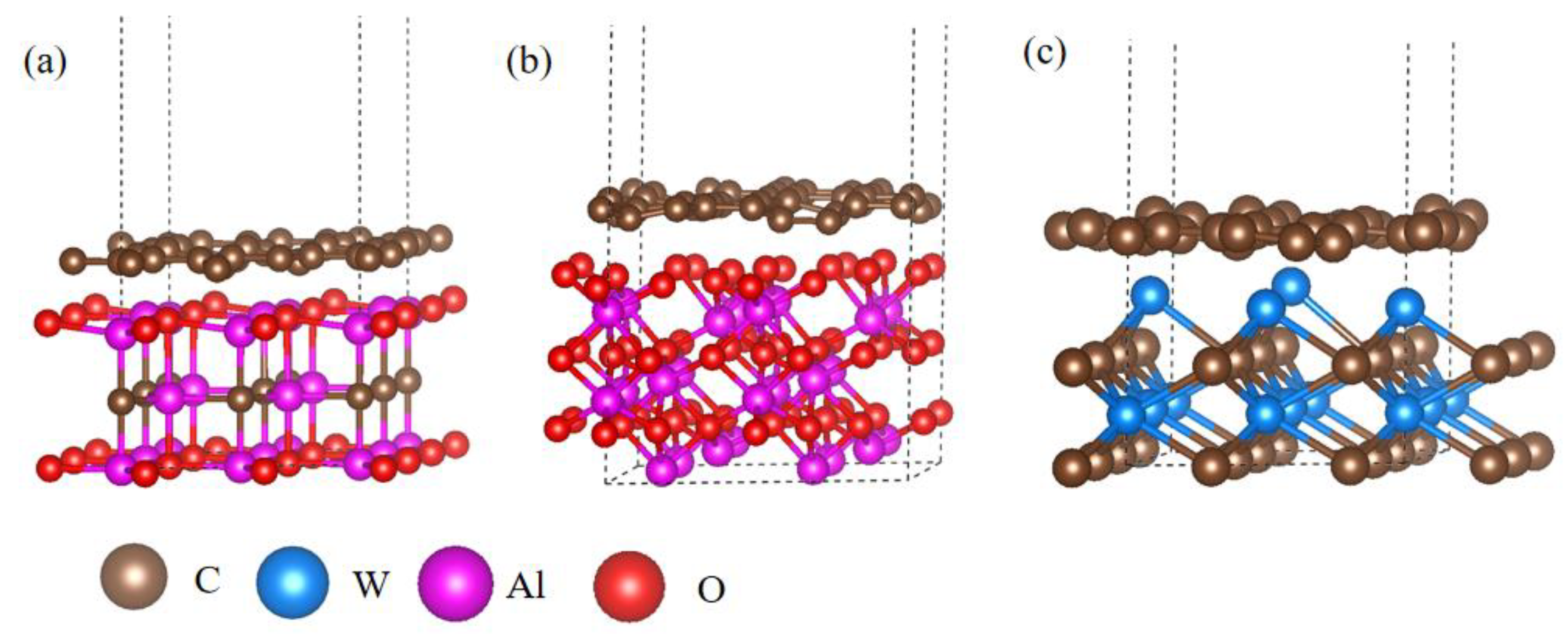

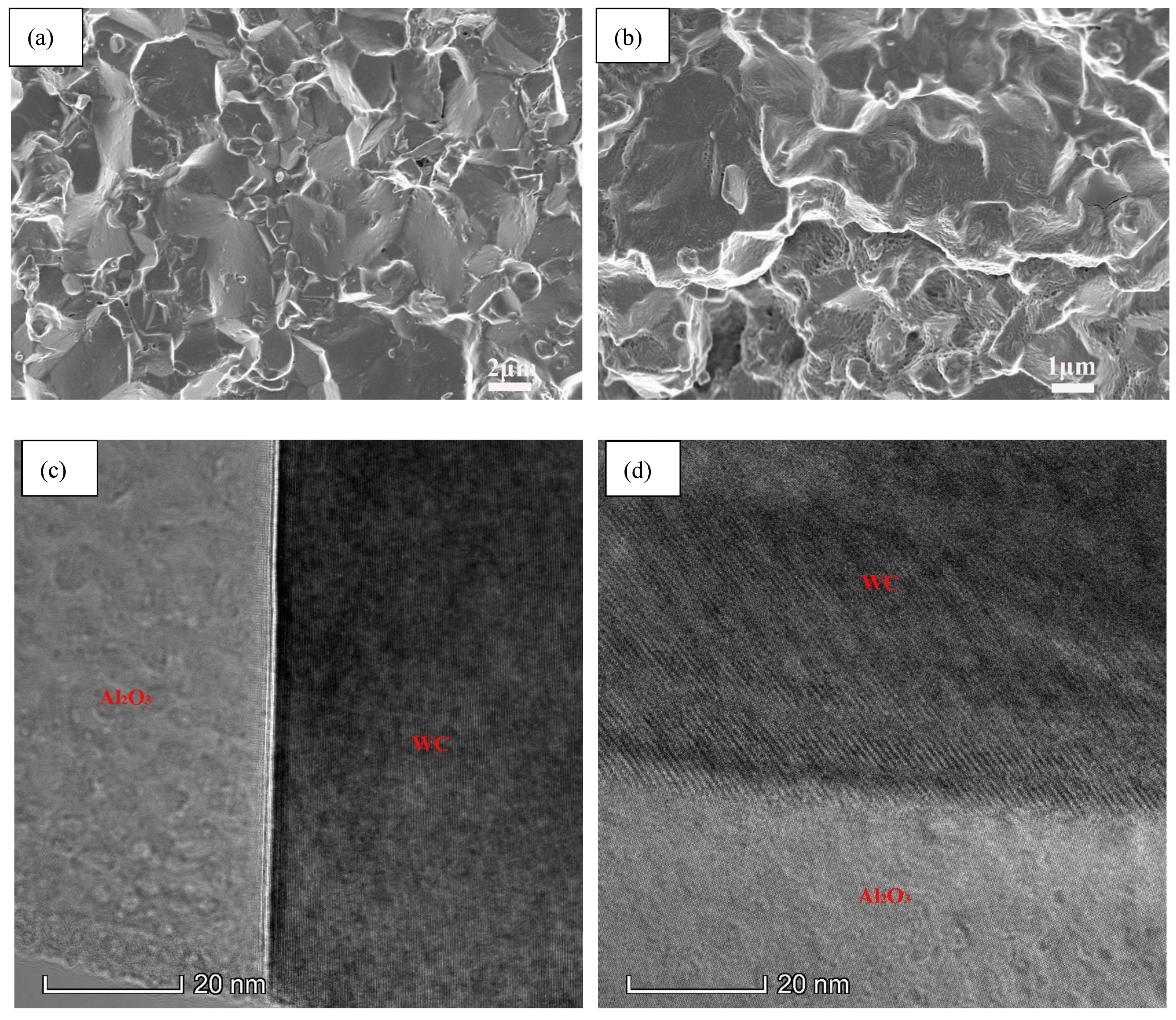
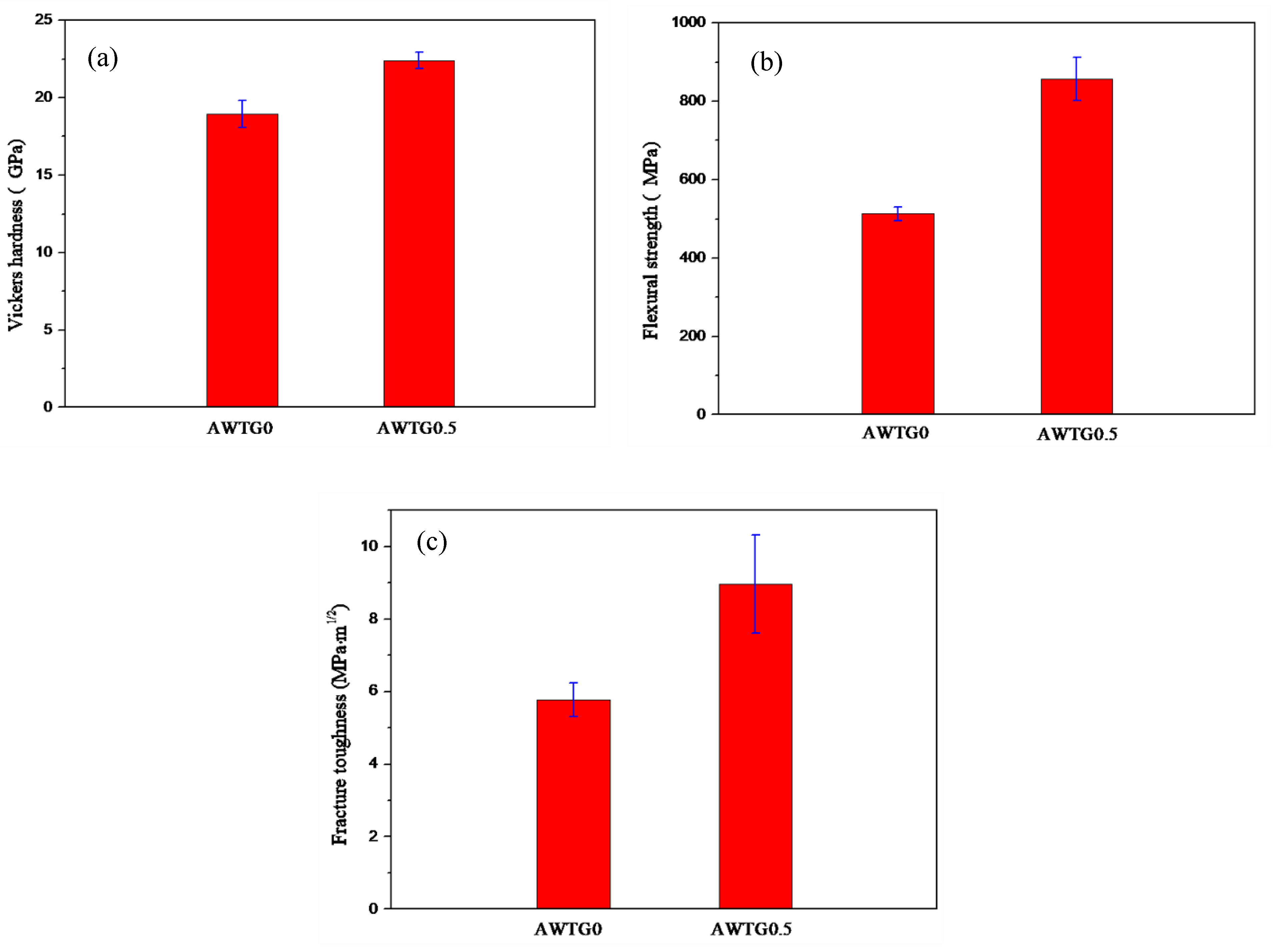
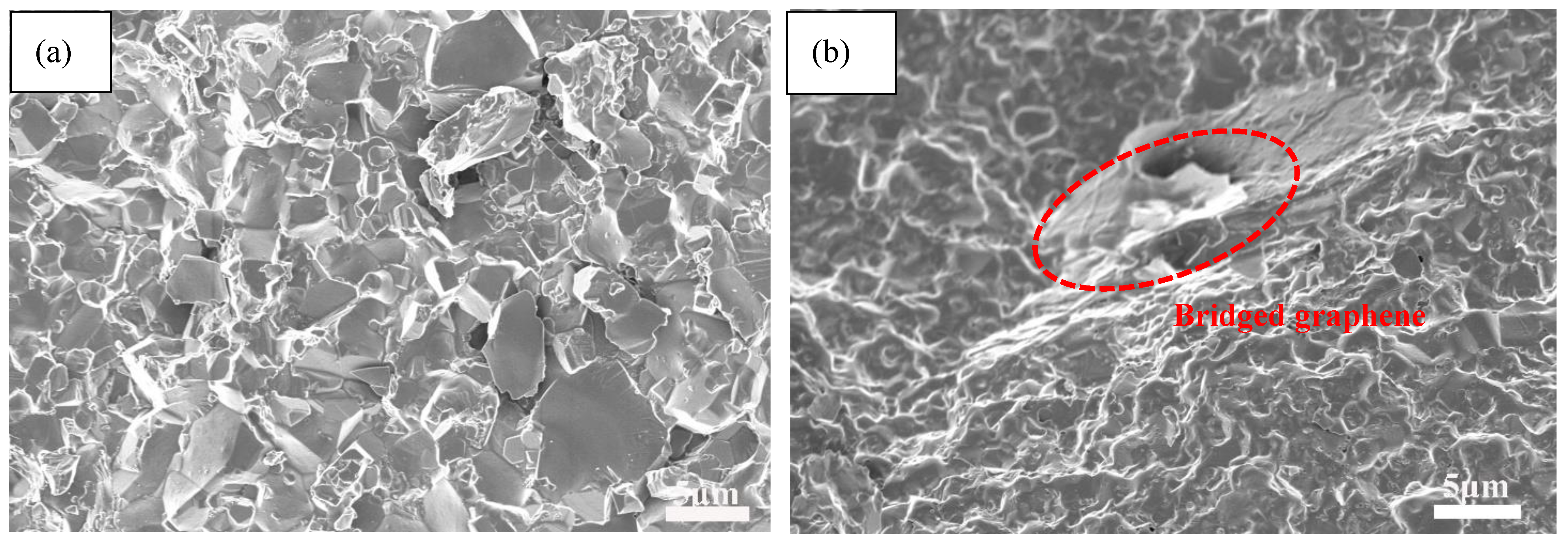
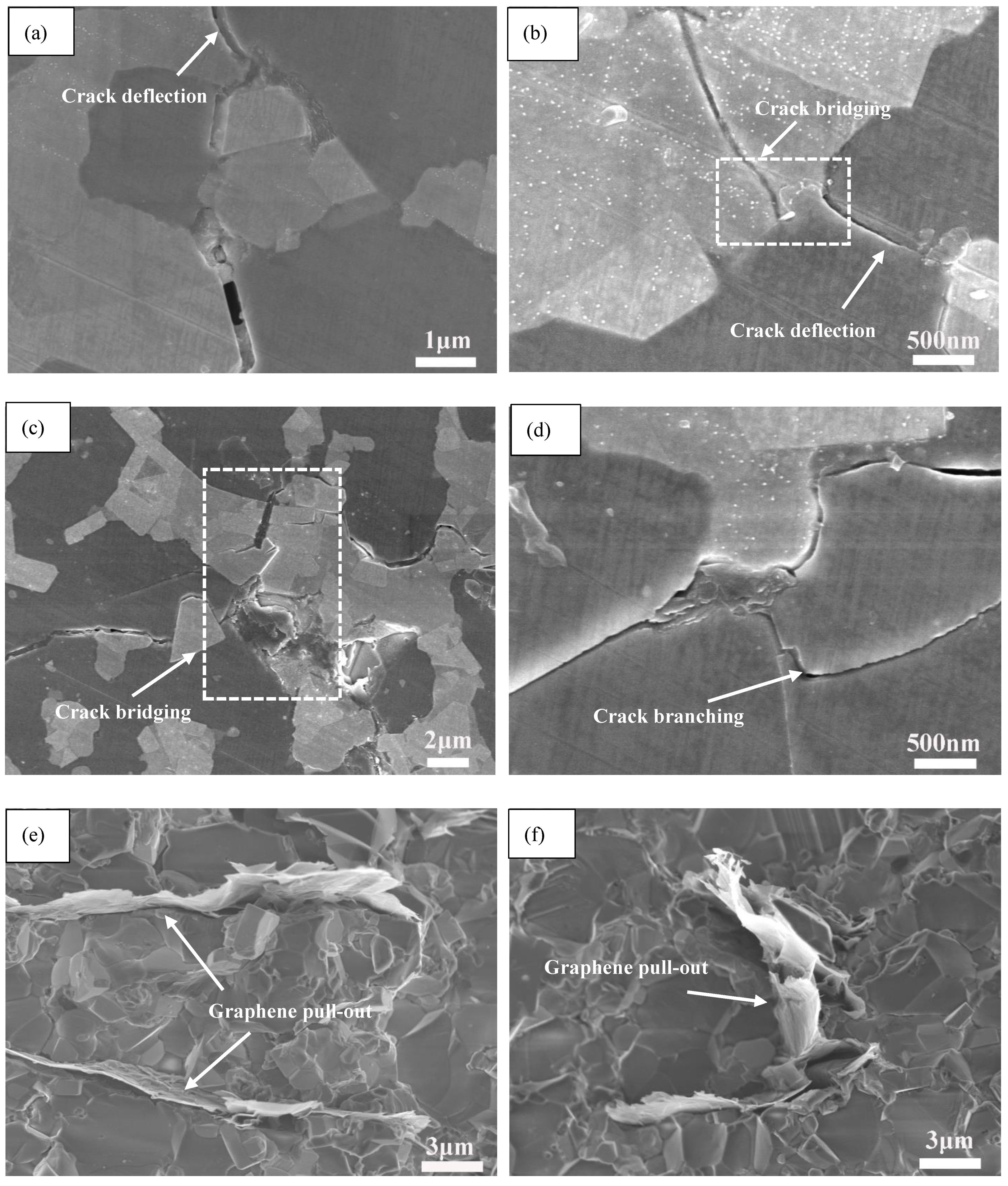
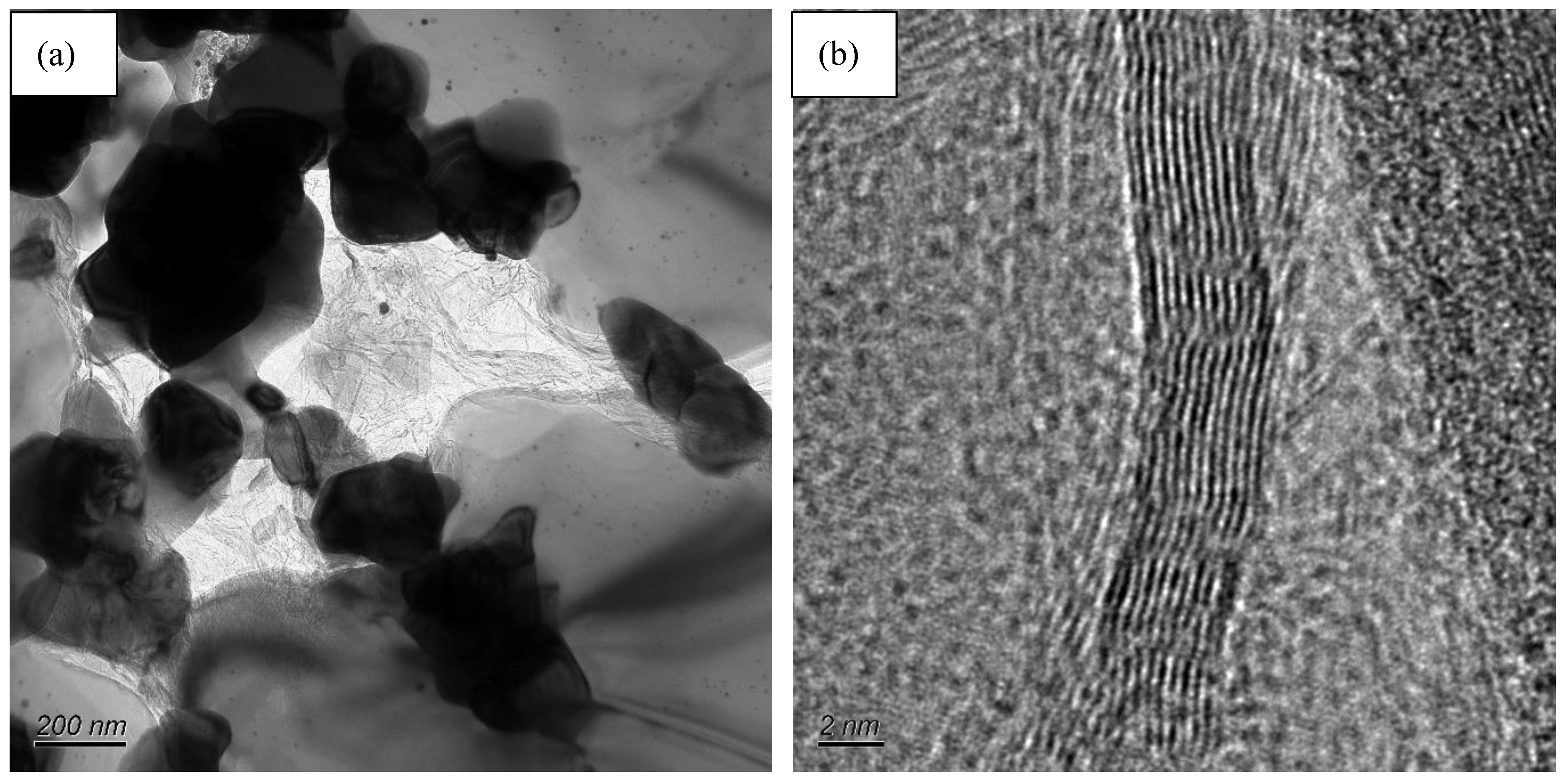
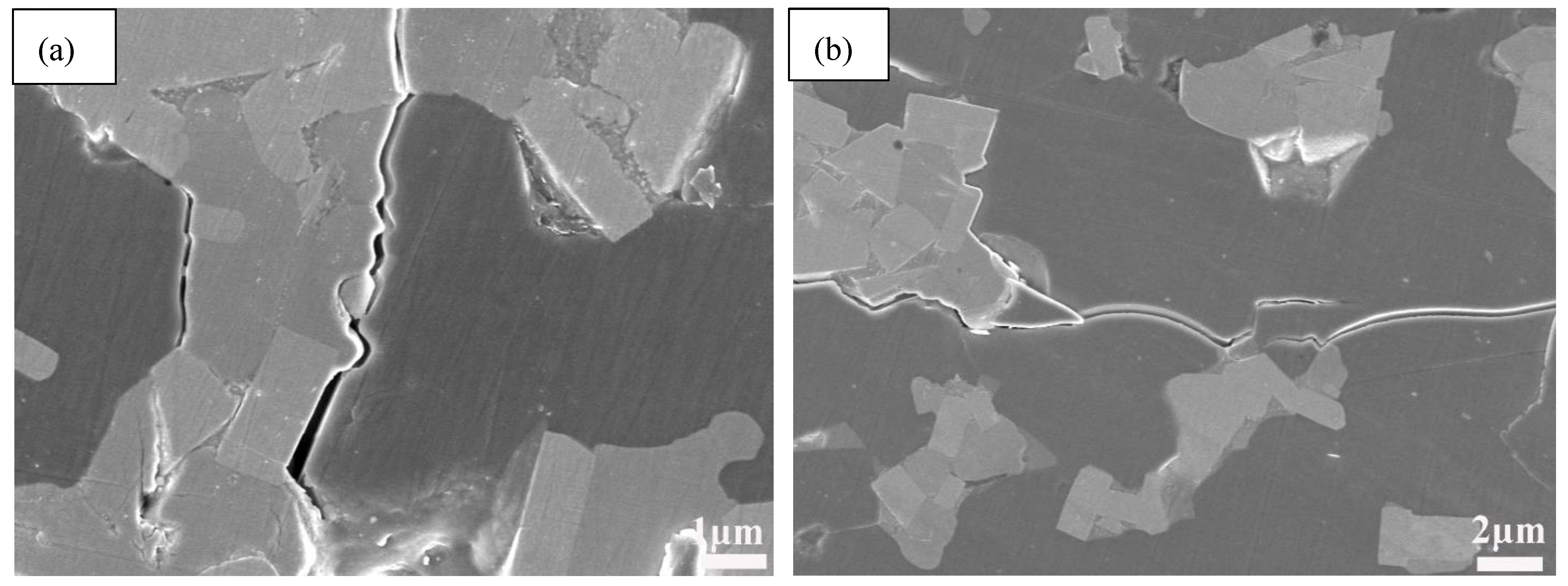
| Specimens | Al2O3 | WC | TiC | MgO | Y2O3 | Co | Graphene |
|---|---|---|---|---|---|---|---|
| AWTG0 | 72 | 18 | 6 | 0.5 | 0.5 | 3 | 0 |
| AWTG0.5 | 71.5 | 18 | 6 | 0.5 | 0.5 | 3 | 0.5 |
| Specimens | Bulk Density (g/cm3) | Relative Density (%) | Average Grain Size (μm) |
|---|---|---|---|
| AWTG0 | 6.17 ± 0.07 | 98.41 | 1.56 ± 0.88 |
| AWTG0.5 | 6.23 ± 0.02 | 99.52 | 0.81 ± 0.45 |
| Interfaces | Adhesion Energy (eV/nm2) | Interfacial Shear Strength (MPa) |
|---|---|---|
| Graphene–Al2OC | 0.287 | 59.32 |
| Graphene–WC | 0.781 | 229.84 |
| Graphene–Al2O3 | 0.967 | 395.77 |
Publisher’s Note: MDPI stays neutral with regard to jurisdictional claims in published maps and institutional affiliations. |
© 2021 by the authors. Licensee MDPI, Basel, Switzerland. This article is an open access article distributed under the terms and conditions of the Creative Commons Attribution (CC BY) license (https://creativecommons.org/licenses/by/4.0/).
Share and Cite
Wang, X.; Zhao, J.; Cui, E.; Tian, X.; Sun, Z. Effect of Interfacial Structure on Mechanical Properties of Graphene Reinforced Al2O3–WC Matrix Ceramic Composite. Nanomaterials 2021, 11, 1374. https://doi.org/10.3390/nano11061374
Wang X, Zhao J, Cui E, Tian X, Sun Z. Effect of Interfacial Structure on Mechanical Properties of Graphene Reinforced Al2O3–WC Matrix Ceramic Composite. Nanomaterials. 2021; 11(6):1374. https://doi.org/10.3390/nano11061374
Chicago/Turabian StyleWang, Xuchao, Jun Zhao, Enzhao Cui, Xianhua Tian, and Zhefei Sun. 2021. "Effect of Interfacial Structure on Mechanical Properties of Graphene Reinforced Al2O3–WC Matrix Ceramic Composite" Nanomaterials 11, no. 6: 1374. https://doi.org/10.3390/nano11061374






